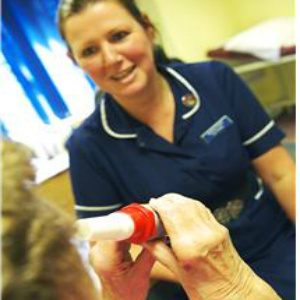Gold standard asthma guidelines back ‘practical’ approach to diagnosis

GP experts have welcomed ‘practical’ advice on asthma diagnosis published today in new gold-standard guidelines, raising further questions over NICE plans to make GPs carry out more rigorous diagnostic testing in primary care.
The final guideline from the British Thoracic Society and Scottish Intercollegiate Guidelines Network (BTS-SIGN), a revision of draft advice published earlier this year, continues to recommend GPs can base a diagnosis on a carefully monitored trial of treatment in patients with suspected asthma, which can include peak flow measures as an alternative to spirometry.
GP respiratory experts said BTS-SIGN was ‘more pragmatic’ than NICE’s planned guidance – which insists on spirometry and FeNO measurements – and provided ‘very clear guidance’ to support GPs, but warned the prospect of NICE bringing in more emphasis on diagnostic testing was ‘unhelpful’.
The guidance – traditionally seen as the gold standard in evidence based care for asthma – reinforces a central role for a trial of treatment in people with suspected asthma.
BTS-SIGN experts who led the guidance said their advice does support use of objective tests, but also stressed there is no ‘magic bullet’ test for diagnosis.
It comes after a row over NICE plans to introduce new guidelines that require GPs to routinely carry out objective tests including spirometry and FeNO to confirm a diagnosis, following claims based on international data that a third of people are wrongly diagnosed with the condition.
NICE has since taken the unprecedented step of putting its final guidelines on hold while it carries out ‘field testing’ in primary care. The final guidance is expected early next year.
But the publication of the BTS-SIGN guidelines in the interim – including references to NICE’s own evaluation of the evidence for each of the objective tests – has effectively over-ruled NICE’s planned approach.
BTS-SIGN stresses that ‘tests influence the probablity of asthma but do not prove a diagnosis’, and that ‘objective tests influence the probability of a diagnosis of asthma, but the magnitude of that influence depends on the probability prior to testing as well as the predictive value of the test’.
It continues: ‘Therefore, in a patient with a very high probability of asthma prior to testing, the results of a diagnostic test with a substantial false negative rate will have minimal influence. In contrast, in a patient with an intermediate or low probability of asthma, a positive diagnostic test may significantly shift the probability towards an asthma diagnosis.’
Dr John White, consultant respiratory physician at York NHS Foundation Trust, who co-chaired the group that developed the BTS-SIGN guidelines, said: ‘Asthma is a complex disease and symptoms can vary over time. In addition, evidence shows there’s still no single ‘magic bullet test’ for asthma. This all means that diagnosis isn’t always easy.
‘This update should be really valuable as it gives healthcare professionals an evidence-based but highly practical approach to suspecting and confirming a diagnosis of asthma, as well as giving the latest guidance on the most appropriate treatments and interventions to combat the disease.’
Dr Noel Baxter, a GP in south London and chair of the UK Primary Care Respiratory Society (PCRS-UK), told Pulse: ‘The BTS-SIGN guidance is absolutely welcomed because it supports current practice and provides very clear guidance on what can be a difficult diagnosis to make.’
Dr Baxter said the guidance was ‘more pragmatic [than NICE’s proposals] because it realises these tests need to be performed over time in the stable and non-stable state in order to accumulate evidence that this is asthma’.
He added: ‘It is possible that the release of the NICE guidance next year may add to this – but in an ideal world we would have a single guideline. It is not helpful to present duplicate guidance when GPs have already got so much to think about.’
Dr Andy Whittamore, GPSI in respiratory medicine in Hampshire and Asthma UK’s clinical lead, said the BTS-SIGN guidance emphasised ’a good history, which is important because it tells you how likely someone is to have asthma or not, but also because it’s such a variable condition – if you perform tests on someone when they don’t have symptoms at the time you can miss the diagnosis’.
He added: ‘What BTS-SIGN say is each of these objective tests has a place in diagnosis but don’t rely on them 100%, although if you can measure some objective proof of inflammation or lung function changing over time then that is good enough as well.’
Read the full BTS-SIGN guidelines here
How guidelines have stoked an asthma diagnosis controversy
BTS/SIGN guidelines on asthma have traditionally been widely recognised as the ‘gold standard’ guidelines for GPs to follow, but NICE has now got in on the act, setting out plans to introduce its own guidelines on diagnosis and monitoring of the condition.
Controversially, NICE claimed their guidelines were needed because there was evidence up to a third of patients with asthma may have been misdiagnosed – and proposed that GPs should in future have to carry out spirometry and bronchodilator reversibility tests, and in some cases FeNO breath tests, in order to confirm a diagnosis in anyone over the age of five.
However, the plans were heavily criticised by GP leaders who questioned the basis for using certain tests and warned they would force GPs to refer large numbers to specialist clinics, while the claims of overdiagnosis provoked a backlash from GP experts on respiratory medicine who have pointed out that NICE’s data was old, and irrelevant to UK practice.
NICE has since taken the unprecedented step of putting the guidelines on hold, until the recommendations have been field tested at practices around the country.
Pulse October survey
Take our July 2025 survey to potentially win £1.000 worth of tokens

Visit Pulse Reference for details on 140 symptoms, including easily searchable symptoms and categories, offering you a free platform to check symptoms and receive potential diagnoses during consultations.












